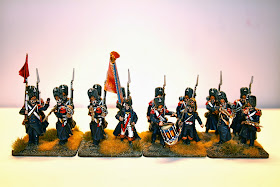The Old Guard - figures and bases from Victrix
From the extremely tall grenadier guards “Die Lange Kerls” of Frederick
the Great to the unholy “Bande Nere” of the Italian Wars and the Jaguar
Warriors of the Aztec – certain units capture our imagination and make their
way into history.
But no unit quite so much as this particular gang of war seasoned old timers.
But no unit quite so much as this particular gang of war seasoned old timers.
The Old Guard was first formed in 1804 using veterans from the campaigns of
Italy and Egypt. They would see service in all mayor campaigns of Napoleon, right to the very last hour at Waterloo.
The Old Guard - following their Emperor on his many campaigns
The minimum requirements to be considered for the Guard were:
The minimum requirements to be considered for the Guard were:
- you could be no older than 35 yrs
- you’d have at least 10 yrs of active service
- you’d be seasoned and noticed in previous campaigns
Like the above mentioned grenadiers of Frederick the Great, the Old Guards
Grenadiers were also drafted from the tallest segment of the army. Average
height was around 1.88 m (ca. 6 ft 2in). Combine that with their impressive fur
hats, and you’d have a very tall and imposing unit coming at you.
A sight not often seen - the Old Guard with their backs turned...
The Old Guard was usually held in reserve. It was a crack formation that
potentially could be the last needed blow that would win the day, or could act
as a human wall covering the retreating army, as seen at Waterloo. Many historians argue that Napoleon often played them too safe, like at
Borodino. If he’d been willing to let the Guard take a crack at the enemy,
things might have been very different. The orderly Russian withdrawal might
have been turned into a rout.
The lovingly applied nickname “Les Grognards” (Grumblers) comes from the
special freedom the Guard Grenadiers enjoyed. They were in fact the only unit
in the whole Grand Armee allowed to make complaints about the conditions of their
field life. And so they did! Often too – and while the Emperor was listening.
This exceptional breach of discipline would normally have been perceived as dishonor or disobedience, and be punished harshly. However Les Grognards had
earned the undying love and respect of their Emperor. And he always listened to
their grumbles.
In 1814, after a frenetic and very hard fought Campaign for France, Napoleon
abdicated.
This would mark the end of the long era of European campaigning. They’d
followed him to the sands of Egypt, to the snow of Mother Russia and back to
fight for every inch of France.
So it was a clearly moved Emperor who said his goodbyes to a likewise teary
eyed Old Guard at Fontainebleau before going into captivity on Elba.
Naturally the Old Guard would stand by their Emperor one more time, as Napoleon
made his last effort in the 100 days campaign, culminating at the defeat by Lord
Wellington at Waterloo in 1815. At this final battle of his career, Napoleon
would have to use his Old Guard one last time – to cover his final retreat.
Legend has it, that in the midst of the hailstorm of bullets thinning the ranks
of the blue-coated men, the enemy - having surrounded them with artillery - offered
the Guard to surrender on good terms. The answer came promptly from Cambronne,
commanding the few proud men still standing: "La garde meurt et ne se rend pas!" (“The Guard dies, it does not
surrender!”).
After the final collapse of Napoleons power many guardsmen simply went back to
whatever normal life they could find. Many of them watched with great suspicion
by the police of the new regime.
When Napoleons body was finally brought back to France in 1840 (he died in 1821
at Longwood, Saint Helena), a great funeral procession was arranged by Thiers.
This would see Napoleon’s remains paraded through central Paris and put to rest
in the grave of Des Invalides.
For this grand procession, these now old men once again dressed in their blue
coats, and for one very last time escorted their Emperor to his final resting
place and into immortality.
Thank you very much for reading!
















